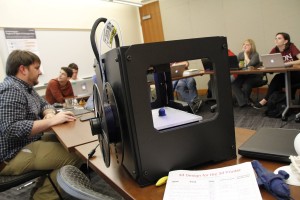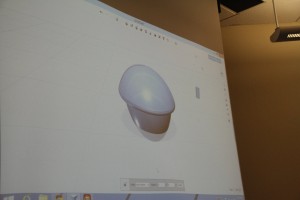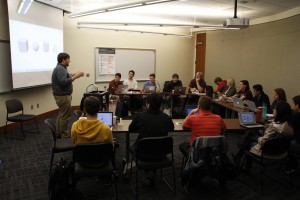Exploring 3D printing during #MakeElon workshop
You may have noticed the large black cart standing in the corner of Belk Library by the Writing Center. On top sits a 3D printer. At Elon’s latest #MakeElon workshop, multimedia developer J.P. Lavoie led the students, faculty and staff who attended through interactive activities to see what exactly a 3D printer is capable of.
3D design for all
The first step to 3D printing is already within your grasp. Printing in 3D requires a 3D model. You can either download a 3D model from the Internet, or you can create your own using 3D modeling software. There are dozens of free 3D design software programs available to download online. For the workshop, Lavoie had his participants download the software Autodesk 1234d, which is available for both PCs and Macs.
Although some programs are more complex and in-depth than others, it’s not a long journey to move from basic programs to advanced ones.
“The cool thing is, all 3D programs have the same basics,” Lavoie said. “If you know one, you know them all.”
Printing acorns
When Lavoie wanted to replicate a toy vehicle for a 3D design project in graduate school, his classmates said it would be much too complicated because of its high level of detail. But Lavoie believes designing 3D objects is a matter of perspective. By using just four shapes; cube, sphere, cylinder, and cone, nearly anything is possible.
“These shapes make up everything,” Lavoie said. “It may look complicated, but that’s all it is. Look at the things around you. They’re all made out of the same basic shapes.”
As an Elon workshop, it was appropriate for participants to use the Autodesk 1234d program to create an acorn. A basic grid helped users stay on track. Starting with two spheres and a cylinder, Lavoie demonstrated how extruding, scaling, rotating, and transforming the shapes can quickly produce the desired result.
Printing in 3D requires more effort than printing in 2D. In order to create a successful 3D design, users must be detail-orientated while remembering the big picture. Lavoie says that like any skill, it takes practice and being patient with mistakes.
“That’s the deal with 3D printing,” Lavoie said. “It’s not going to be perfect because nothing is. I printed [an acorn] four times today!”
Blasting off with 3D printing
Two engineering courses have already utilized 3D printing. One class actually designed rockets, which they used the 3D printer to print and then launch. See the results here. Teaching and Learning Technologies hopes to have a 3D printer in a makerspace here at Elon for both classwork and independent student work.
“A Makerspace as a whole could foster innovation,” Lavoie said. “I could never physically hold something I created. This [3D printing] gives me the ability to do that.”
3D printing is only one type of technology shown at a #MakeElon workshop. If you’re interested in getting involved with making on campus, check out the list of upcoming maker-inspired events and workshops.



 Follow
Follow